
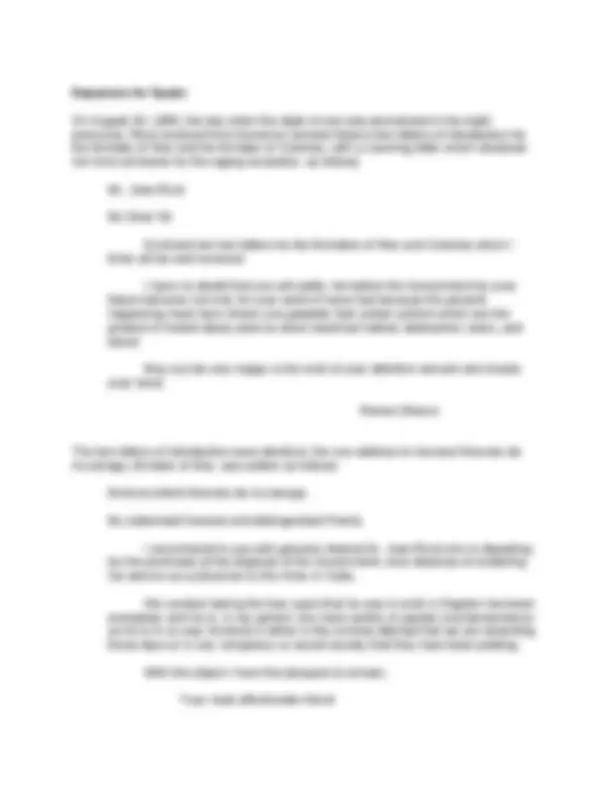
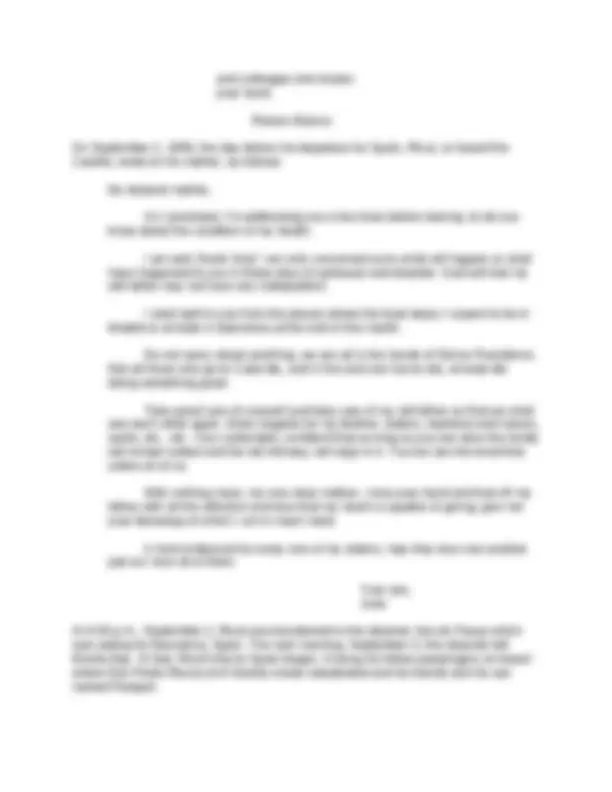
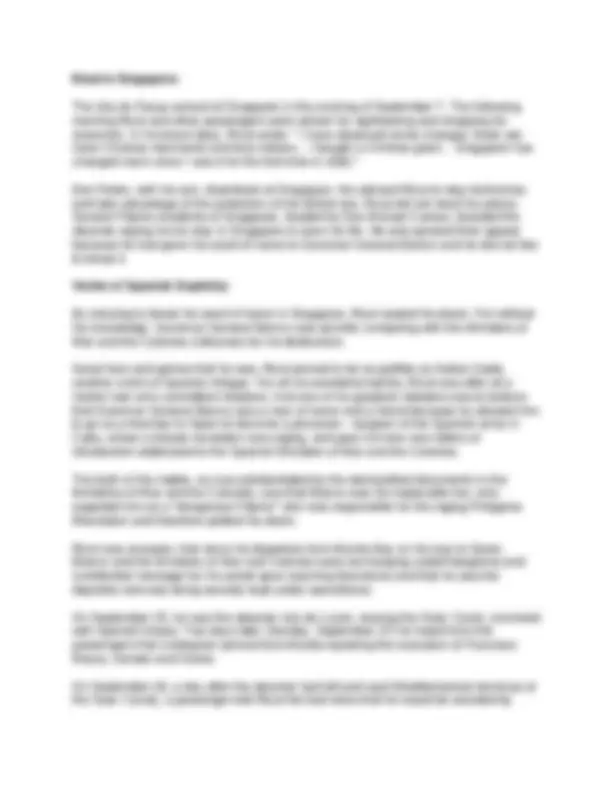
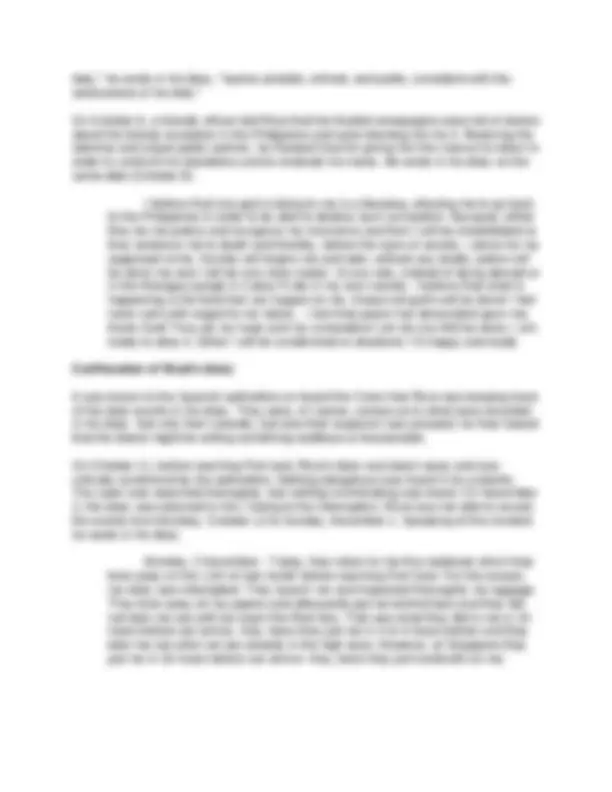
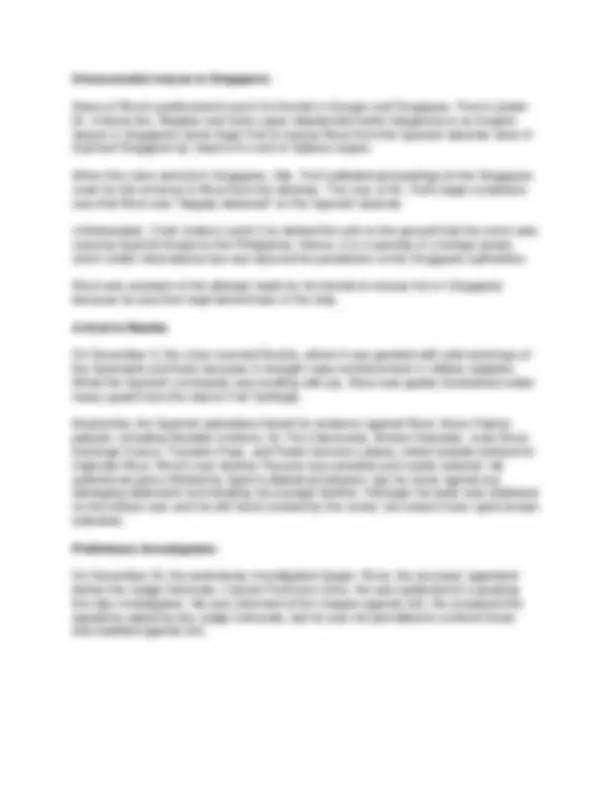


Study with the several resources on Docsity

Earn points by helping other students or get them with a premium plan


Prepare for your exams
Study with the several resources on Docsity

Earn points to download
Earn points by helping other students or get them with a premium plan
Community
Ask the community for help and clear up your study doubts
Discover the best universities in your country according to Docsity users
Free resources
Download our free guides on studying techniques, anxiety management strategies, and thesis advice from Docsity tutors
This document recounts rizal's last trip abroad in 1896, detailing his stops in various philippine cities and his eventual transfer to the spanish cruiser castilla. The text also describes the outbreak of the philippine revolution and rizal's reaction to the news while on the castilla. The document sheds light on the political climate of the time and the events leading to rizal's eventual arrest and imprisonment.
Typology: Schemes and Mind Maps
1 / 9

This page cannot be seen from the preview
Don't miss anything!






Chapter 23 Last trip abroad, (1896) No longer and exile, Rizal had a pleasant trip from Dapitan to manila, when delightful stopovers in Dumaguete, Cebu, Iloilo, Capiz, and Romblon. He missed the regular steamer Isla de luzon which sailed to Spain the day before he arrived in Manila Bay. While waiting for the next ship in Spain he was kept as a "guest" on board the Spanish cruiser Castilla. Meanwhile, on august 26, 1896, Andres Bonifacio and the Katipunan raised the cry of revolution in the hills of Balintawak, a few miles of north of Manila. Rizal, worried about the raging hostilities left for Spain on the steamer Isla de panay on September 3, 1896. It was his last trip abroad. From Dapitan to Manila: Leaving Dapitan at midnight, july 31, 1896, the Españya , with Rizal and the party on board, sailed northward. At dawn the next day (Saturday, august 1) it anchored at Dumaguete, capital of Negros Oriental. "Dumaguete", wrote Rizal in his travel diary, "spread out on the beach. There are big houses, some with galvanized iron roofing. Outstanding are the house of a lady whose name I have forgotten, which is occupied by the government and another one just begun with many ipil post". In Dumaguete, Rizal visited a friend and former classmate, Herrero Regidor, who was the judge of the province. He also visited other friends, including the Periquet and Rufina families. In the afternoon he operated on a Spanish captain of the Guardia Civil. The España left Dumaguete about 1:00 p.m. and reach Cebu the following morning. Rizal was fascinated by the entrance to Cebu which he considered "beautiful". At the house of Attorney Mateos he met an old couple whom he had known in Madrid. "In Cebu", he wrote in his diary, "I did two operations of strabotomy, one operation on the ears, and another of tumor". In the morning of Monday august 3, Rizal left Cebu going to Iloilo. "The voyage was fine," he wrote, "At the night we saw Mactan, an island famous for what happened to Magellan. The whole afternoon was magnificent... We saw many islands along our way... The next day, in the morning, we entered Iloilo".... Rizal landed at Iloilo, went shopping in the city, and visited Molo. Of the Molo church, he commented: "The church is pretty outside in the interior is not bad, considering that it had been painted by a lad. The paintings are mostly copies of biblical scenes by Gustave Dore". From Iloilo, Rizal’s ship sailed to Capiz. after a brief stopover, it proceeded towards Manila via Romblon.
Rizal misses ship going to Spain: The España arrived in Manila Bay early in the morning of Thursday, august 6, 1896. Unfortunately, Rizal was not able to catch the mail ship Isla del Luzon for Spain because it had departed the previous day at 5:00 p.m. He was greatly disappointed, but he took this unlucky incidence with abiding resignation. Writing to Bluementritt later, Rizal mentioned this episode, "Unfortunately", he said "I did not catch the mail ship for Spain, and fearing that my stay in Manila for a month might bring me troubles I made known to the Governor General, while remaining on board the ship (España – Z.), of my wish to be isolated from everybody, except my family". Near midnight of the same day, august 6, Rizal was transferred to the Spanish cruiser Castilla , by order of Governor General Ramon Blanco. He was given good accommodation by the gallant captain, Enrique Santalo, who told him that he was not a prisoner, but a guest detained on board "in order to avoid difficulties from friends and enemies". Rizal stayed on the cruiser for about a month, from August 6 to September 2, 1896, pending the availability of a Spain-bound steamer. Outbreak of the Philippine Revolution: While Rizal was patiently waiting on the cruiser Castilla for the next steamer to take him to Spain, portentous event occurred, presaging the downfall of Spanish power in Asia. On the faithful event of august 19, 1896, the Katipunan plot to overthrow Spanish rule by means of revolution was discovered by Frey Mariano Gil. Augustinian cura of Tondo. This startling incident struck terror into the hearts of the Spanish officials and residents, producing a hysteria of vindictive retaliation against the Filipino Patriots. The tumult produced by the discovery of the Katipunan plot was aggravated by the "Cry of Balintawak" which was raised by Bonifacio and his valiant Katipuneros on August 26,
and colleague who kisses your hand. Ramon Blanco. On September 2, 1896, the day before his departure for Spain, Rizal, on board the Castilla , wrote to his mother, as follows: My dearest mother, As I promised, I’m addressing you a few lines before leaving, to let you know about the condition of my health. I am well, thank God; I am only concerned as to what will happen or shall have happened to you in these days of upheaval and disorder. God will that my old father may not have any indisposition. I shall right to you from the places where the boat stops; I expect to be in Madrid or at least in Barcelona at the end of this month. Do not worry about anything; we are all in the hands of Divine Providence. Not all those who go to Cuba die, and in the end one has to die, at least die doing something good. Take good care of yourself and take care of my old father so that we shall see each other again. Many regards for my brother, sisters, nephews and nieces, aunts, etc., etc. I live contended, confident that as long as you are alive the family will remain united and the old intimacy will reign in it. You too are the bond that unites all of us. With nothing more, my very dear mother, I kiss your hand and that off my father with all the affection and love that my heart is capable of giving; give me your blessings of which I am in much need. A fond embraced for every one of my sisters; may they love one another just as I love all of them. Your son, Jose At 6:00 p.m., September 2, Rizal was transferred to the steamer Isla de Panay which was sailing for Barcelona, Spain. The next morning, September 3, this steamer left Manila Bay. At last, Rizal's trip to Spain begun. Among his fellow passengers on board where Don Pedro Roxas (rich Manila creole industrialist and his friend) and his son named Periquin.
Rizal in Singapore: The Isla de Panay arrived at Singapore in the evening of September 7. The following morning Rizal and other passengers went ashore for sightseeing and shopping for souvenirs. In his travel diary, Rizal wrote: " I have observed some changes: there are more Chinese merchants and less Indians... I bought a Chinese gown... Singapore has changed much since I saw it for the first time in 1882." Don Pedro, with his son, disembark at Singapore. He advised Rizal to stay behind too and take advantage of the protection of the British law. Rizal did not heed his advice. Several Filipino residents of Singapore, headed by Don Manuel Camus, boarded the steamer urging him to stay in Singapore to save his life. He also ignored their appeal because he had given his word of honor to Governor General Blanco and he did not like to break it. Victim of Spanish Duplicity: By refusing to break his word of honor in Singapore, Rizal sealed his doom. For without his knowledge, Governor General Blanco was secretly conspiring with the Ministers of War and the Colonies (Ultramar) for his destruction. Great hero and genius that he was, Rizal proved to be as gullible as Sultan Zaide, another victim of Spanish intrigue. For all his wonderful talents, Rizal was after all a mortal man who committed mistakes. And one of his greatest mistakes was to believe that Governor General Blanco was a man of honor and a friend because he allowed him to go as a freeman to Spain to become a physician - surgeon of the Spanish army in Cuba, where a bloody revolution was raging, and gave him two nice letters of introduction addressed to the Spanish Ministers of War and the Colonies. The truth of the matter, as now substantiated by the declassified documents in the Ministries of War and the Colonies, was that Blanco was his implacable foe, who regarded him as a "dangerous Filipino" who was responsible for the raging Philippine Revolution and therefore plotted his doom. Rizal was unaware, that since his departure from Manila Bay on his way to Spain, Blanco and the Ministers of War and Colonies were exchanging coded telegrams and confidential message for his arrest upon reaching Barcelona and that he was the deportee and was being secretly kept under surveillance. On September 25, he saw the steamer Isla de Luzon , leaving the Suez Canal, crammed with Spanish troops. Two days later (Sunday, September 27) he heard from the passengers that a telegram arrived from Manila reporting the execution of Francisco Roxas, Genato and Osorio. On September 28, a day after the steamer had left port said (Mediterranean terminus of the Suez Canal), a passenger told Rizal the bad news that he would be arrested by
Z.], With its monumental and magnificent castle in three levels... Illumined by the lingering afternoons lights.” On October 3, at 10:00 in the morning, the Isla de Panay arrived in Barcelona; with Rizal a prisoner on board. The trip from Manila to Barcelona lasted exactly 30 days. He was kept under heavy guard in his cabin for 3 days. His jailor was no longer the ship captain but the Military Commander of Barcelona, who happened to be General Eulogio Despujol, the same one who ordered his banishment to Dapitan in July, 1892., It was one of those coincidence in the lives of men that make "history stranger than fiction." On his second day in Barcelona, Rizal, although held incommunicado in his cabin, noticed the city celebration of the feast of St. Francis of Assisi. He recorded it in his diary as follows: " at 6:00 in the morning many cannon shots awakened us. It seems that they are in honor of the feast of St. Francis of Assisi... At 12:00 I counted as many as 31 canon shots and at 6:00 there were again as many. At night there was a concert in a dining room which can be heard from my cabin." At 3:00 a.m. on October 6, Rizal was awakened by the guards and escorted to the grim and infamous prison-fortress name Monjuich. He spent the whole morning in a cell. About 2:00 in the afternoon, he was taken out of prison by the guards and brought to the headquarters of General Despujol. In the interview, which lasted a quarter of an hour, the brusque general told Rizal that he would be shipped back to Manila on board the transport ship Colon which was leaving that evening. After the interview, Rizal was taken aboard the Colon , which was "full of soldiers and officers and their families." At 8:00 p.m., October 6, the ship left Barcelona, with Rizal on board. Chapter 24: Last Homecoming and Trial Rizal's homecoming in 1896, the last in his life, was his saddest return to his beloved native land. He knew he was facing the supreme test, which might mean the sacrifice of his life, but he was unafraid. As a manner of fact, he welcomed it. Gladly, he decided to meet his enemies and to offer himself as a sacrificial victim to their sadistic lust and unholy design for he knew that his blood would water the seeds of Filipino freedom. The trial that was held shortly after his homecoming was one of history's mockeries of justice. His enemies howled like mad dogs for his blood, and they got it, without benefit of genuine justice. A Martyr's Last homecoming: Day by day, since living Barcelona on Tuesday, October 6, 1896, Rizal conscientiously recorded the events in his diary. He was given a good cabin in the second class and all those strictly guarded, he was courteously treated by the army officers. "The officers on
duty," he wrote in his diary, "seems amiable, refined, and polite, consistent with the seriousness of his duty." On October 8, a friendly officer told Rizal that the Madrid newspapers were full of stories about the bloody revolution in the Philippines and were blaming him for it. Realizing the adverse and unjust public opinion, he thanked God for giving him the chance to return in order to confront his slanderers and to vindicate his name. He wrote in his diary on the same date (October 8): I believe that one god is doing to me is a blessing, allowing me to go back to the Philippines in order to be able to destroy such accusation. Because, either they do me justice and recognize my innocence and then I will be rehabilitated or they sentence me to death and thereby, before the eyes of society, I atone for my supposed crime. Society will forgive me and later, without any doubt, justice will be done me and I will be one more martyr. At any rate, instead of dying abroad or in the Manigua (jungle in Cuba) I'll die in my own country. I believe that what is happening is the best that can happen to me. Always let god's will be done! I feel more calm with regard to my future... I feel that peace has descended upon me, thank God! Thou art my hope and my consolation! Let me you Will be done; I am ready to obey it. Either I will be condemned or absolved. I'm happy and ready. Confiscation of Rizal's diary: It was known to the Spanish authorities on board the Colon that Rizal was keeping track of the daily events in his diary. They were, of course, curious as to what were recorded in his diary. Not only their curiosity, but also their suspicion was aroused, for they feared that the diarist might be writing something seditious or treasonable. On October 11, before reaching Port said, Rizal's diary was taken away and was critically scrutinized by the authorities. Nothing dangerous was found in its contents. The cabin was searched thoroughly, but nothing incriminating was found. On November 2, the diary was returned to him. Owing to the Interruption, Rizal was not able to record the events from Monday, October 12 to Sunday, November 1. Speaking of this incident he wrote in his diary. Monday, 2 November - Today, they return to me this notebook which they took away on the 11th of last month before reaching Port Said. For this reason, my diary was interrupted. They search me and inspected thoroughly my luggage. They took away all my papers and afterwards put me behind bars and they did not take me out until we reach the Red Sea. That was what they did to me in 16 hours before our arrival. Also, twice they put me in 4 or 6 hours before and they take me out when we are already in the high seas. However, at Singapore they put me in 16 hours before our arrival. Also, twice they put handcuffs on me.